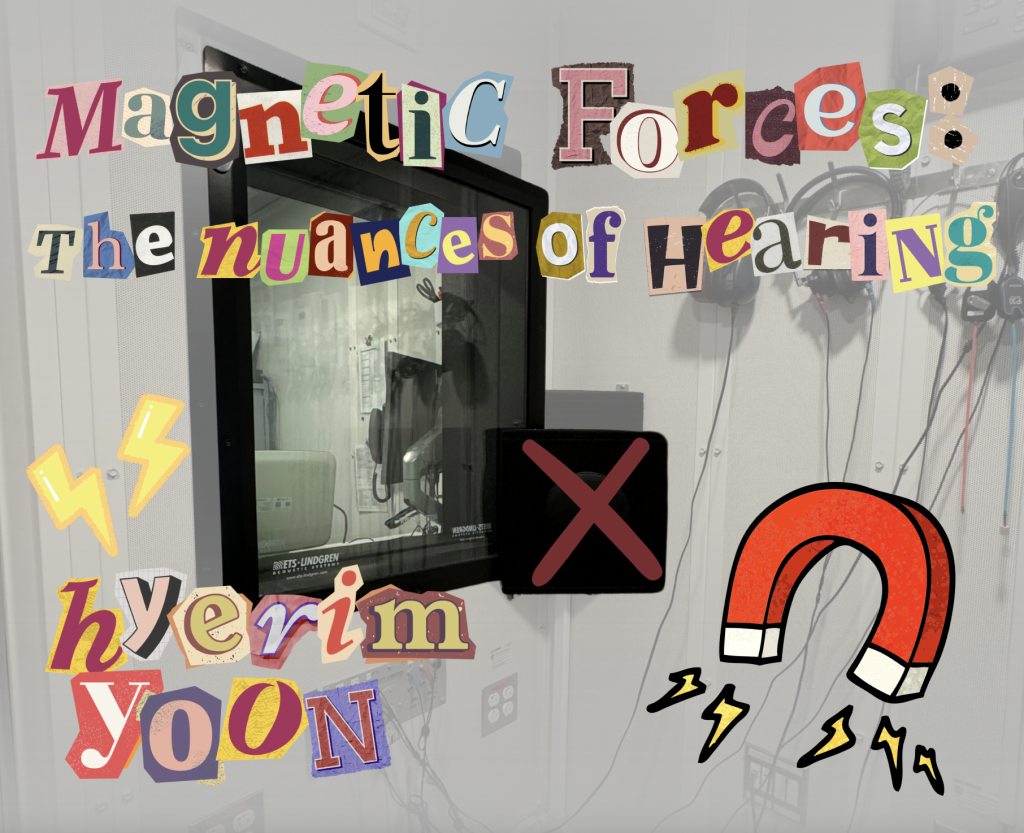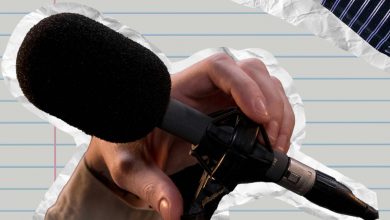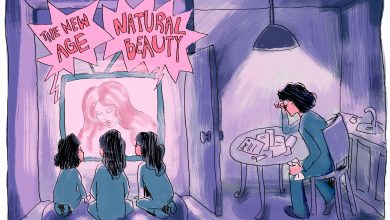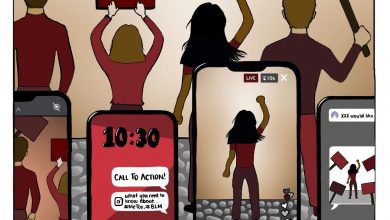Magnetic Forces: The Nuances of Hearing
Image Description: A collage with headphones in the background, a magnet, and lightning bolts. The letters spell out “Magnetic Forces: The Nuances of Hearing” by “Hyerim Yoon”
The cliche of counting back from ten is one of the only things I remember about that day. My vision, blurry without the usual lenses that accompany them, made note that the operating room looked nothing like what “Grey’s Anatomy” conditioned me to anticipate. The only other thing that I do remember is what I felt like after I woke up.
After asking my nurse to move my bed up and down on five separate occasions, I remember feeling like throwing up. The pressure of what felt like fluid in my ear and the aching feeling in my heart knowing that my residual hearing would eventually disappear to make room for this device was making my head pound even more.
I concluded — under an immense amount of pain killing medication — that this whole situation was my fault for choosing to hide my hearing loss for so long. After coming clean and receiving my official diagnosis for something that I’d carried for all my life at 14, I rejected every option for a hearing aid, let alone a cochlear implant.
Although I grew up in a society that is slow to accommodate and normalizes fully hearing people, I was fine living with my hearing loss. Yes, it was annoying to continuously advocate for myself everywhere I went (which is the sad reality for many, if not all folks with disabilities), but I was happy with the way I had been living. I saw no need for change — in my head, a hearing aid or cochlear implant would have completely thrown off the balance of my life.
At 18, my audiologist informed me that my hearing had worsened significantly since we last met. Like every appointment before it, the impending doom and intrusive thoughts of how it would play out for me and how to break the news to my fully hearing family rushed in my head. How would I explain this to my mother? No, how would I explain this to the rest of my family, who were anticipating good news at home? To them, my hearing loss was a weakness and a danger. It was surely my own fault for letting it get worse. Seeing my family react to this news was the deciding factor in me taking (possibly) the biggest step of my life.
Months before the surgery, I scoured the internet to educate myself on everything that I could find regarding the d/Deaf and Hard of Hearing spectrum, as well as cochlear implants. Living the entirety of my life hiding my disability and being surrounded by fully hearing people, I had grown up looking down at my hearing loss, even if it is all that I have ever known. Because of this, I didn’t think to do independent research earlier on in my life. My lived experiences were a huge contributing factor in my decision to study the various nuances of hearing loss.
As I started to learn more about hearing loss, I discovered that it wasn’t a “one size fits all” experience. Each of the four main types of hearing loss have different implications for those who experience them. This includes conductive hearing loss, sensorineural hearing loss, mixed hearing loss, and auditory neuropathy spectrum disorder. Although I wasn’t looking for it explicitly, I found patterns within the sources that I scoured and learned how unfairly hearing loss can impact different demographics of people. According to the World Health Organization, “nearly 80% of people with disabling hearing loss live in low- and middle-income countries.” It was also revealed to me that “those identifying as white/caucasian were statistically significantly more likely to report familiarity with cochlear implants than those identifying as Black/African American and Hispanic/Latino/Spanish,” and among those with difficulty hearing, “nearly 80% report having never talked with a medical or hearing care professional about cochlear implants,” which influences the current widespread underutilization of cochlear implants within the United States.
These facts personally gave me a lot to think about, especially when it came to where I categorize myself in the vast world of d/Deaf and Hard of Hearing individuals. I considered my privilege, as well as second thoughts that were beginning to arise. This led me to do a deep dive and learn more about the rich Deaf culture that I hadn’t been exposed to prior. I didn’t know where to even begin in order to address this vast community or where I would even fit within it. My only wish is that I had been integrated into this culture earlier, rather than holding onto my strict, medicalized view of deafness set by the world that I grew up in.
This is also when I came to realize the controversy that surrounded cochlear implants for those in the Deaf community. Certain Deaf culturalists believe that “cochlear implant technology deprives the Deaf community of members and threatens Deaf culture,” with “cochlear implants represent[ing] a form of minority oppression.” This was a perspective that I had not previously considered before — although I felt like I was forced to learn everything so fast, I realized that ultimately, I still had the final say regarding my surgery. Even though I had not been integrated into the culture, I was old enough to recognize why cochlear implant technology would be problematic to the Deaf community.
Sharing the worries of Deaf culturalists, I considered those, like young children, that lack the ability to make their own choice. Over 90% of deaf children have hearing parents who want their children to hear and speak, making them more likely to receive cochlear implants. While parents that believe that d/Deafness is a way of life rather than a disability are less likely to consider implantation for their children, unfortunately, they are still in the minority. The more harmful and ableist assumption that being d/Deaf or Hard of Hearing is something that needs to be “fixed” or “cured” appears to be more popular in our society, which has taken away the luxury of choice for many young people.
The decision by families to utilize cochlear implants ultimately threatens Deaf culture, especially considering that the “cultural transmission of Deaf culture does not occur within families, but rather, through Deaf institutions.” Children that grow up being immersed in the culture through schools and advocacy groups dedicated to supporting the Deaf community are crucial to the advancement of the institutions that they are a part of. With cochlear implants also leading to a decline in ASL speakers, a fear continues to grow within the community that “fewer people will participate in Deaf institutions,” which would make Deaf culture eventually disappear. This is an incredibly valid concern — the Deaf community is vastly underrepresented everywhere, including social media, compared to other cultural minorities and causes.
Similarly to my personal experience, there is additionally a growing number of individuals that don’t realize where they would fit within Deaf and Hard of Hearing culture, making them less likely to take the initiative to learn more. Less funding for these institutions also means that less resources are available to those that may benefit from it. This is a systemic problem, and similarly to what was mentioned earlier, it holds especially true for people of color. It goes both ways — many people do not receive the proper information needed for cochlear implants as well as how to immerse themselves within Deaf and Hard of Hearing culture.
Recently, there has also been online discourse accusing Deaf culturalists of “victimizing themselves and creating trouble.” This relatively new technology — invented in 1982 — was seen by the world as an “important advancement that creates opportunities for Deaf individuals,” and people began to blame the Deaf community for valuing the “interests of a culture over the interests of an individual.” However, the belief that the government was “actively scheming to destroy Deaf culture” and even commit “genocide” by “funding cochlear implant research” brought up serious concerns.
The idea that a d/Deaf or Hard of Hearing person has to adapt to the hearing world rather than the other way around made me recognize that the problem isn’t hearing loss — it’s living in a society that is inherently ableist with no intent to change.
I reflected on my own experiences — there had been many moments while hiding my disability where I felt embarrassed by the fact that I couldn’t hear well, but, as I got older, I was proud of the way that I had been born. I saw no fault and no mistake in my hearing loss. I was comfortable with the “lack” of sound and I couldn’t imagine what a hassle a cochlear implant would be. Still, to please those I loved most, I decided to move forward with the process anyways.
Although I was a qualified candidate for this surgery, I didn’t know that I would be receiving it until the day of. My surgery was poorly scheduled; I went to sleep the night before not knowing that the next day, my entire life would change. When it came time for the actual procedure, I went through what I could only describe as the worst week of my life. On the car ride to the hospital, I experienced second thoughts and tried my hardest to cherish each minute of my life before this abrupt change. I wanted more time to learn before I was essentially forced to live with this device for the rest of my life — it all felt too sudden. This is why when it was time to get my cochlear implant activated a week post-surgery, I didn’t know exactly what to expect. I never truly prepared myself for the reality of living life with this device.
Even with all the research that I had conducted, nothing could have prepared me for the sheer lack of understanding my peers possessed for my experience. While mourning the closed chapter of my life pre-surgery, I began to notice little “jokes” everywhere, from my own friends and family to social media. Although I am certain that they were meant to be supportive and understanding of my experience, the jokes of me becoming a “magnet sensor” or “deaf Iron Man” and endless questions of whether or not my “hearing is better now” became too much to deal with at once.
There is a vague timeline for improvements in sound quality and speech comprehension after receiving a cochlear implant, and yet it felt like I had a ticking time bomb inside my head. The people in the hearing world around me could not realize that d/Deafness is a spectrum, not something that gets “cured.” The anticipation for a “speedy recovery” made me feel as though I wasn’t meeting their exact expectations. Combined with the endless “jokes” and “inspiration porn” that portrayed me and other individuals with a cochlear implant as “heroic” or “inspirational” for choosing to go forward with surgery, I found myself immensely overwhelmed.
I am not your “magnetic superhero.” I am not helpless. Don’t make me into something that fits your needs because it is more convenient for you, and don’t push me into a category because it makes more sense to you.
When I woke up from my surgery and opened this chapter of my life, I didn’t anticipate just how jarring and lonely the journey ahead would be. I still do not know where I fit in, and I continue to learn new things everyday, which has made me realize that every single person has a different story to tell.
Although I’m still trying to figure everything out for myself, I’ve realized that what’s important and needs urgent attention is the fact that disabled people are under attack by the U.S. government. As of January 2025, Section 504, “an important law that protects people with disabilities,” is being threatened in seventeen U.S. states. This includes the basic rights and accommodations of all disabled people, including those that are d/Deaf or Hard of Hearing. According to the Disability Rights Education and Defense Fund (DREDF), the rules in Section 504 say that:
- Schools must include students with disabilities and help them learn.
- Doctors and schools must have sign language interpreters for people who are Deaf and Hard of Hearing who sign. Videos must have captions.
- Doctors must give clear information to disabled people. This includes people with intellectual and developmental disabilities.
- Websites for schools and hospitals must work for people who are blind and low vision.
- Doctors and hospitals cannot stop helping someone because they have a disability.
- Doctors and hospitals must have tools and machines that work for wheelchair users. This includes machines that check for cancer.
Section 504 provides necessary accommodations like assistive listening devices and systems, computer-assisted transcription (CART), and flashing fire alarms, among many other things that are necessary for the safety and day-to-day lives of all disabled individuals, including d/Deaf and Hard of Hearing people.
The attack on Section 504 is a reminder to bring disabilities and d/Deafness into our day-to-day conversations. It is a daily struggle, and we as people moving towards a more understanding and compassionate future must collectively work to change our mindsets that were shaped by the ableist world that we live in. We must fight for the dismantling of the current system that exists as a whole so that the basic needs and accommodations of every person with a disability are recognized as protected rights, not something we fear losing.





